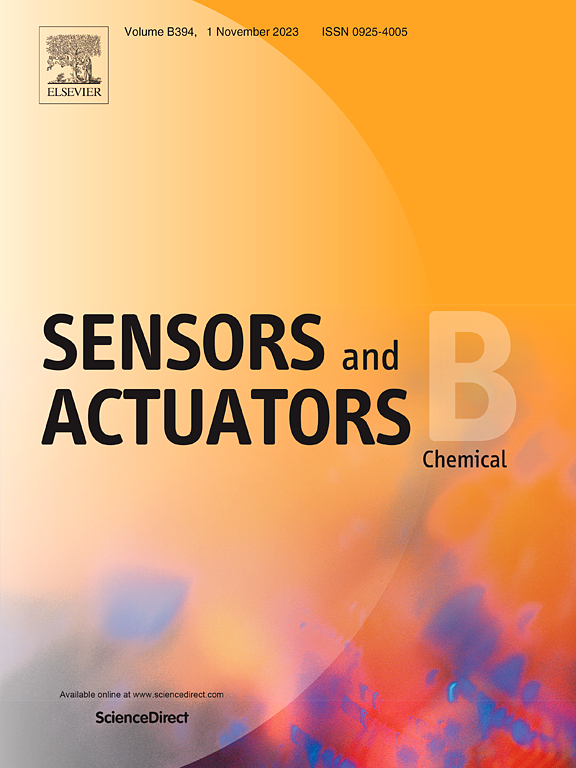Dual-mode photoelectrochemical/colorimetric sensor for CTCs detection based on seaurchin-like LaNiCo/Pd nanozymes and Exo-DNAzyme cascade program
IF 8
1区 化学
Q1 CHEMISTRY, ANALYTICAL
引用次数: 0
Abstract
Circulating tumor cells (CTCs) as a new biomarker of liquid biopsy, play an important role in the early diagnosis and dynamic monitoring of cancer, and their precise detection method has attracted increasing attention. Herein, an ultrasensitive and accurate photoelectrochemical (PEC)/visual colorimetric (VCL) dual-mode aptasensing platform is developed for CTCs assay based on lanthanum-doped seaurchin NiCo2O4 decorated with palladium (LaNiCo/Pd) nanozymes and Exo-DNAzyme cascade multisignal program. The as-synthesized LaNiCo/Pd nanozymes can not only be used as a multifunctional signal amplifier to significantly weaken the photocurrent of TiO2 nanospheres, but also efficiently catalyze the 3,3′,5,5′-tetramethylbenzidine (TMB) visual color reaction. The precise identification of aptamer-targeted CTCs not only improves detection specificity, but also activates the cascade amplification of ExoIII and Zn2+-DNAzyme. By integrating LaNiCo/Pd nanozymes with Exo-DNAzyme, lower detection limits of 7 and 22 cells/mL for PEC and VCL analysis for A549 cells are achieved. The established aptasensor also effectively distinguishes cancer patients from healthy persons (P < 0.05), indicating the significant potential in early clinical diagnosis. Overall, the developed dual-mode PEC/VCL aptasensing platform as a simple and powerful strategy can meet the on-site point-of-care testing and precise laboratory analysis of CTCs.

基于LaNiCo/Pd纳米酶和Exo-DNAzyme级联程序的ctc检测双模光电化学/比色传感器
循环肿瘤细胞(Circulating tumor cells, CTCs)作为一种新的液体活检生物标志物,在肿瘤的早期诊断和动态监测中发挥着重要作用,其精确检测方法越来越受到人们的关注。在此基础上,基于钯(LaNiCo/Pd)纳米酶和Exo-DNAzyme级联多信号程序,建立了一种超灵敏、精确的电化学/视觉比色(VCL)双模适体感应平台,用于ctc的检测。合成的LaNiCo/Pd纳米酶不仅可以作为多功能信号放大器,显著减弱TiO2纳米球的光电流,还可以高效催化3,3 ',5,5 ' -四甲基联苯胺(TMB)的视觉显色反应。精确识别适配体靶向ctc不仅提高了检测特异性,而且激活了ExoIII和Zn2+-DNAzyme的级联扩增。通过将LaNiCo/Pd纳米酶与Exo-DNAzyme整合,实现了A549细胞PEC和VCL分析的低检出限分别为7和22个细胞/mL。所建立的适体传感器也能有效区分癌症患者和健康人(P<0.05),在临床早期诊断中具有显著的潜力。总体而言,所开发的双模PEC/VCL感应平台作为一种简单而强大的策略,可以满足ctc的现场护理点检测和精确的实验室分析。
本文章由计算机程序翻译,如有差异,请以英文原文为准。
求助全文
约1分钟内获得全文
求助全文
来源期刊

Sensors and Actuators B: Chemical
工程技术-电化学
CiteScore
14.60
自引率
11.90%
发文量
1776
审稿时长
3.2 months
期刊介绍:
Sensors & Actuators, B: Chemical is an international journal focused on the research and development of chemical transducers. It covers chemical sensors and biosensors, chemical actuators, and analytical microsystems. The journal is interdisciplinary, aiming to publish original works showcasing substantial advancements beyond the current state of the art in these fields, with practical applicability to solving meaningful analytical problems. Review articles are accepted by invitation from an Editor of the journal.
 求助内容:
求助内容: 应助结果提醒方式:
应助结果提醒方式:


